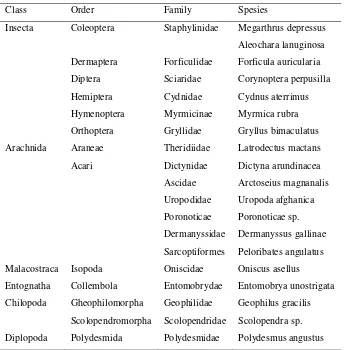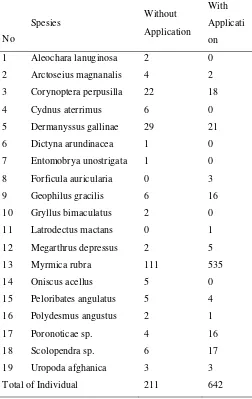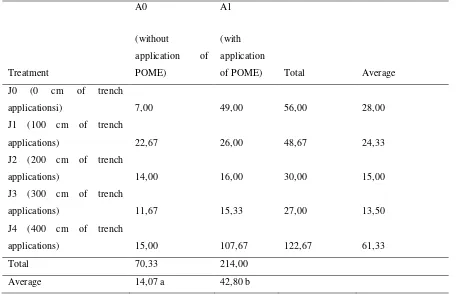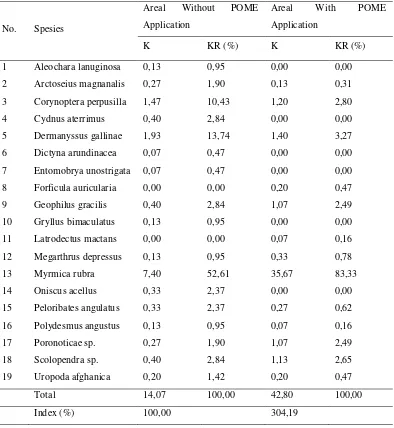International Journal of Sciences:
Basic and Applied Research
(IJSBAR)
I SSN 2 3 0 7 - 4 5 3 1
(Print & Online)
http://gssrr.org/index.php?journal=JournalOfBasicAndApplied
---
Arthropods Population in Palm Oil Plantation with and
without Applications of Palm Oil Mill Effluent
Sakiah
a*, Mariani Sembiring
b, Luqmanul Hakim
ca,cPlantation, STIPER Agrobisnis Perkebunan (STIPAP), Medan, Indonesia
bFaculty of Agriculture, University of Sumatera Utara, Indonesia
aEmail: [email protected]
bEmail: [email protected]
Abstract
Arthropods role are very important in overhauling organic and inorganic matter, and together with other soil
organism, participate in the process of biogeochemical cycles. Environmental factors affect the presence of
organisms in the soil, including Arthropods. The factors which affecting the availability of Arthropods in soil
are moisture, soil temperature, soil pH and soil organic matter. So it is necessary to study the type and amount
of Arthropods contain in land applied by palm oil mill effluent, and as a benchmark on land that is not applied
by palm oil mill effluent. This research was conducted to determine the type and amount of arthropods cropland
which produce palm oil with the application and without the application of palm oil mill effluent. The research
used randomized complete block design with 2 factors and 3 replications. Factor 1: land with application and
without the application of palm oil mill effluent, Factor 2: the sampling soil distance of 0 cm, 100 cm, 200 cm,
300 and 400 from the trench of palm oil mill effluent application. The results showed that the application of
palm oil mill effluent contributes a significant effect on arthropods population. Arthropods population in the
areas with the application of palm oil mill effluent is more common at a distance of 400 cm from the application
ditch (A1J4). Arthropods found in the area without the application and with the application of palm oil mill
effluent consists of 6 classes, 13 orders, 18 families and 19 species. The six classes are Insecta, Arachnida,
Malacostraca, Entognatha, Centipede and Diplopoda.
Keywords: Arthropods; Diversity; Microorganism; Palm Oil Mill Effluent.
---
International Journal of Sciences: Basic and Applied Research (IJSBAR)(2017) Volume 32, No 1, pp 20-28
21
1.Introduction
Export commodities development of palm oil in Indonesia continues to increase from year to year. Palm oil mill
effluent containing organic compound materials biodegrade in anaerobic atmosphere becomes simple acid
compound, particularly acetic acid and gas. With the biological processes in an anaerobic atmosphere, levels of
Biochemical Oxygen Demand (BOD) can be reduced from 25,000 mg/l to 5,000 mg/l. The research result from
Pusat Penelitian Kelapa Sawit (PPKS) showed that Pabrik Kelapa Sawit (PKS) which is efficient enough
produce 0.6-0.8 m³ of liquid waste (POME)/ton Fresh Fruit Bunches treated [5].
Increased biodiversity can bring benefits to economy and environment. Arthropods have a very vital role in the
food chain, especially as decomposers, because without these organisms nature will not recycle organic
materials. In addition, Arthropods also act as prey for small predators, so it will keep the continuity of other
Arthropod [6].
Besides a role in the food web, Arthropods also play a role in soil decomposition. Arthropods on soil surface
will destroy larger size substance into smaller size one so that decomposition process can be continued by other
soilfauna [4].
The utilization of palm oil mill effluent that has been processed into the plantation area as a fertilizer will give
effect to soilfauna in particular from the group of Arthropods, both the existence types, density, frequency of
attendance and the community structure (species diversity) in the area [1].
Soil macrofauna found in palm oil plantations which applied with palm oil mill effluent are the kind of insects
that consists of eight orders, namely: Blattaria, Coleoptera, Hemiptera, Hymenoptera, Isoptera, Orthoptera and
Neuroptera [10].
Arthropods existence of the habitat depends on environmental conditions [8]. Palm oil mill effluent affecting
the diversity of arthropods due to a higher diversity of arthropods found in the plantation area irrigated by
POME than plantation area which is not irrigated by POME [7].
Based on that statement, this study was conducted to compare the population of arthropods in oil palm
plantations with the application and without the application of palm oil mill effluent, so can inventory the types
of arthropods which found in the field.
2. Material and Methods
This research was conducted in Divisi A Kebun Pengarungan PT. Asam Jawa Torgamba, Kabupaten Labuhan
Batu Selatan, Sumatera Utara in March to July, 2016. The palm oil mill effluent are derived from progenitor
pool is distributed to Flat Bed with the size of the trench (18 x 1.25 x 1.25) m³. The applications of palm oil mill
effluent to Areal Land Application were done by tractor tank system.
International Journal of Sciences: Basic and Applied Research (IJSBAR)(2017) Volume 32, No 1, pp 20-28
channel trench with a certain slope. Soil samples were collected with a size of 20 cm x 20 cm x 10 cm.
2.1. Experimental Design
The study used Factorial Randomized Block Design with two factors and 3 replications. Factor I was soil
applications of palm oil mill effluent and land without the application of palm oil mill effluent. Factor II was
soil sampling retrieval distance which consists of 5 levels i.e.: 0 cm, 100 cm, 200 cm, 300 cm, and 400 cm from
the trenches application of palm oil mill effluent. Each treatment consists of three replications.
Testing parameters of the Arthropods average population are arranged on the list of variance and Least
Significant Difference (LSD) test is done with the level of 5% and 1%
2.2. Observation and Interpretation of Data
The observations made in this study are:
1. Arthropods Classification
2. The Population of Arthropods
3. Population Abundance and Relative Abundance; Calculation and interpretation of the data obtained at
each point of observation is done in the following manner:
Fauna Population Abundance and Relative Abundance [9]
K type A = ... (1)
KR type A = ... (2)
Note:
K = Population Abundance
KR = Relative Abundance
Interpretation:
1) If A is a type of fauna that are beneficial to agriculture, the higher the value of K or KR mean soil
management and crop cultivation leads to sustainability of cultivation.
2)If A is a type of fauna detrimental to agriculture, the higher the value of K or KR mean soil management and
crop ecologically unfavorable and at a certain value (threshold) threatens the sustainability of cultivation. It is
International Journal of Sciences: Basic and Applied Research (IJSBAR)(2017) Volume 32, No 1, pp 20-28
23
3. Result and Discussion
3.1 Arthropods Classification
Arthropods found in the area without the application and with the application of palm oil mill effluent are quite
varied in existence. Arthropods which are obtained from the research are grouped in classes, orders, families
and species (Table 1)
Table 1: Classification of Arthropods on Areal Without and With Application of Palm Oil Mill Effluent
Class Order Family Spesies
Arthropods found in the study site consist of 6 classes, 13 orders, 18 families and 19 species. Classes obtained
in the area of research are Insecta (insects), Arachnid (spider), Malacostraca (flea dirt), Entognatha (spring
tails), Centipede (centipedes) and Diplopoda (millipedes).
3.2 Total Population of Arthropods
Arthropods number of each type in an area without the application and with the application of palm oil mill
International Journal of Sciences: Basic and Applied Research (IJSBAR)(2017) Volume 32, No 1, pp 20-28
Table 2: Number of Arthropod population by type
No
Spesies Without
Application
With
Applicati
on
1 Aleochara lanuginosa 2 0
2 Arctoseius magnanalis 4 2
3 Corynoptera perpusilla 22 18
4 Cydnus aterrimus 6 0
5 Dermanyssus gallinae 29 21
6 Dictyna arundinacea 1 0
7 Entomobrya unostrigata 1 0
8 Forficula auricularia 0 3
9 Geophilus gracilis 6 16
10 Gryllus bimaculatus 2 0
11 Latrodectus mactans 0 1
12 Megarthrus depressus 2 5
13 Myrmica rubra 111 535
14 Oniscus acellus 5 0
15 Peloribates angulatus 5 4
16 Polydesmus angustus 2 1
17 Poronoticae sp. 4 16
18 Scolopendra sp. 6 17
19 Uropoda afghanica 3 3
Total of Individual 211 642
Arthropods population is mostly found in the areas with palm oil mill effluent application by 642 individual
(304.26% compared to areas without application), while in areas without application found as many as 211
individual. The overall number of species found that 19 species, in an area without the application only 17
species (Latrodectus mactans and Forficula auricularia are not found). While in the area with application there
are 13 species and 6 species are not found; Aleochara lanuginosa, Cydnus aterrimus, Dyctina arundinacea,
Entomobrya unostrigata, Gryllus bimaculatus, and Oniscus asellus.
Differences in the type and number of arthropods which found in areas without application and with the
application of mill effluent prove that the presence of the organism, especially arthropods in the soil is
influenced by environmental factors. Arthropod existence in one habitat depends on environmental conditions
[8]. Reference [7] stating that palm oil mill effluent affecting the diversity of arthropods, due to a higher
diversity of arthropods found in the plantation area irrigated by POME than plantation which is not irrigated by
International Journal of Sciences: Basic and Applied Research (IJSBAR)(2017) Volume 32, No 1, pp 20-28
25
Arthropod population show higher average number in the area with mill effluent application than in area
without application. Arthropod population of trench applications is also varies. The average population of
arthropods (Table 3)
Table 3: The average population of arthropods (individual)
Treatment
applications) 15,00 107,67 122,67 61,33
Total 70,33 214,00
Average 14,07 a 42,80 b
The highest Arthropods population is in the treatment with the application of mill effluent at a distance of 400
cm (A1J4) that is equal to 107.67 and the lowest is on treatment without application of mill effluent at a
distance of 0 cm (A0J0) that is equal to 7.00. LSD test showed that the area of the mill effluent application give
significant effect on arthropods when compared with the total areal without application of the wastewater. In the
(A1) areas where wastewater is applied, Arthropods on average is 42.80 while in areas without application of
POME (A0) is lower at 14.07. In the treatment of soil sampling distance can be seen that LSD test showed that
the distance does not significantly affect total Arthropods. However, at a distance of 400 cm from the
application ditch there was an increase in total Arthropods. This happens because at a distance of 400 cm from
the POME application ditch is close to the palm roots. According to Lines-Kelly [3] rhizosphere is an
environment in the soil around the roots of a plant where the chemical and its biological activity are influenced
by the roots directly. In line with the growth of plant roots secrete compounds that are soluble in water, for
example amino acids, sugars and organic acids that will provide food for microorganisms. The availability of
food supply has resulted in the microorganisms activity around rhizosphere is much higher than around a far
International Journal of Sciences: Basic and Applied Research (IJSBAR)(2017) Volume 32, No 1, pp 20-28
3.3 Population Abundance and Relative Abundance
Population abundance and relative abundance of Arthropods in areas without application and the application of
palm oil mill effluent can be seen in Table 4.
Table 4: Population Abundance and Relative Abundance of Arthropods in Areal Without Application and the
Application of POME
No. Spesies
Areal Without POME
Application
Areal With POME
Application
K KR (%) K KR (%)
1 Aleochara lanuginosa 0,13 0,95 0,00 0,00
2 Arctoseius magnanalis 0,27 1,90 0,13 0,31
3 Corynoptera perpusilla 1,47 10,43 1,20 2,80
4 Cydnus aterrimus 0,40 2,84 0,00 0,00
5 Dermanyssus gallinae 1,93 13,74 1,40 3,27
6 Dictyna arundinacea 0,07 0,47 0,00 0,00
7 Entomobrya unostrigata 0,07 0,47 0,00 0,00
8 Forficula auricularia 0,00 0,00 0,20 0,47
9 Geophilus gracilis 0,40 2,84 1,07 2,49
10 Gryllus bimaculatus 0,13 0,95 0,00 0,00
11 Latrodectus mactans 0,00 0,00 0,07 0,16
12 Megarthrus depressus 0,13 0,95 0,33 0,78
13 Myrmica rubra 7,40 52,61 35,67 83,33
14 Oniscus acellus 0,33 2,37 0,00 0,00
15 Peloribates angulatus 0,33 2,37 0,27 0,62
16 Polydesmus angustus 0,13 0,95 0,07 0,16
17 Poronoticae sp. 0,27 1,90 1,07 2,49
18 Scolopendra sp. 0,40 2,84 1,13 2,65
19 Uropoda afghanica 0,20 1,42 0,20 0,47
Total 14,07 100,00 42,80 100,00
Index (%) 100,00 304,19
Based on Table 4 it can be seen that the population abundance of arthropods in oil palm plantations in the area
of POME application is very high at 42.80 (304.19% compared with no POME application). In areas without
POME application that is equal to 14.07. Myrmica rubra species in areas without POME has an abundance of a
population of 7.40 with a relative abundance of 52.61%. Population abundance increased in the areas where the
International Journal of Sciences: Basic and Applied Research (IJSBAR)(2017) Volume 32, No 1, pp 20-28
27
According to Borror and his colleagues [2] that Hymenoptera order contains lots of valuable species as parasites
or predators of insect pests and the most important pollinators of plants; the bees. Hymenoptera is one group
that is very attractive in terms of their biology, because they show great diversity of habits and increased
behaviors complexity in terms of social organization of hornets, bees, and ants.
Myrmica rubra species is a species that give benefit for both agriculture and plantation because their nest is
inside the soil and will decompose organic matter faster. The higher the value of population abundance and
relative abundance make the soil and plants cultivation leads to sustainability cultivation.
4.Conclusion
1. Arthropods found in the study site consist of 6 classes, 13 orders, 18 families and 19 species. Kelas
yang ditemukan adalah kelas Insecta, Arachnida, Malacostraca, Entognatha, Chilopoda dan Diplopoda.
2. Application of palm oil mill effluent on plantations gives significant effect on the population growth of
Arthropods.
3. Total population of arthropods on POME application land is as much as 642 individuals, on land
without POME applications is 211 individuals.
4. Arthropods population abundance in palm oil plantations is highest in areas with the POME
application of 42.80 and in areas without POME application of 14.07.
References
[1] Arlen. "Kajian Pengaruh Pemupukan Dengan Limbah Cair Pabrik Kelapa Sawit ke Areal Kebun
Terhadap Cacing Tanah Untuk Memantau Kualitas Tanah secara Biologis." Magister. Thesis,
University of Sumatera Utara, Medan, 1998.
[2] Borror, D.J., Triplehorn, C.A., dan Johnson, N.F. Pengenalan Pelajaran Serangga, 6th ed. Yogyakarta :
Gadjah Mada University Press, 1992.
[3] Lines-Kelly, R. "Defend the Rhizosphere and Root Against Pathogenic Microorganisms. Internet :
http://ice.agric.uwa.edu.au/soils/soilhealth. 2005 ( 22 Oktober 2016)
[4] Odum, E.P. Fundamental of Ecology. W. B. Saunders. Tokyo, 1993.
[5] Pamin, K., Siahaan, M.M., Tobing, P.L. Pemanfaatan Limbah Cair Pabrik Kelapa Sawit Pada
Perkebunan Kelapa Sawit Di Indonesia in Lokakarya Nasional Pemanfaatan Limbah Cair Dengan Cara
Land Aplication. Pusat Penelitian Kelapa Sawit, Medan, 1996.
[6] Samudra, F. B., Izzati, M., Purnaweni, H. "Kelimpahan dan Keanekaragaman Arthropoda Tanah di
Lahan Sayuran Organik “Urban Farming” in Prosiding Seminar Nasional Pengelolaan Sumber Daya
International Journal of Sciences: Basic and Applied Research (IJSBAR)(2017) Volume 32, No 1, pp 20-28
[7] Simamora, M. L. Diversitas Makro Arthropoda Tanah Akibat Limbah Cair PKS di Kebun PTPN III Sei
Simalungun. Bachelor. Skripsi. University of Sumatra Utara, 2011.
[8] Suin, Nurdin Muhammad. Ekologi Hewan Tanah. Jakarta : Bumi Aksara , 1997.
[9] Suin, Nurdin Muhammad. Ekologi Hewan Tanah. Jakarta : Bumi Aksara, 2003.
[10] Widhiastuti, R., Suryanto D., Mukhlis, Wahyuningsih H. "Pengaruh Pemanfaatan Limbah Cair Pabrik
Kelapa Sawit sebagai Pupuk terhadap Biodiversitas Tanah." Jurnal Ilmiah Pertanian KULTURA Vol.



